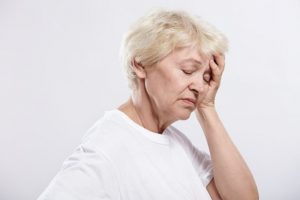
Postprandial hypotension: Causes, symptoms, and treatment
Postprandial hypotension is low blood pressure after a meal. This condition can manifest itself as dizziness or lightheadedness that affects nearly one-third of older men and women.
Proper digestion is accomplished when the functioning of the digestive, nervous, and circulatory systems are precisely coordinated. Extra blood is directed to the intestines and stomach. To compensate for this diversion of blood circulation, the heart beats faster and blood vessels narrow. This helps maintain blood pressure to other parts of the body.
If the blood vessels and the heart do not respond the way they should, you may experience low blood pressure elsewhere in the body while the digestive organs are completing the process of digestion. This can lead to symptoms associated with low blood pressure. Continue reading…
Dizziness after standing results from a drop in blood pressure, but it could also be a more serious condition known as delayed orthostatic hypotension. Whether you got up too quickly from a seated or lying position, from time to time it seems that motion can cause dizziness.
Orthostatic hypotension (OH) is a condition characterized by low blood pressure when you stand up. It may be accompanied by feelings of dizziness or lightheadedness. OH is often minor, lasting for a few seconds or minutes, but long-lasting OH can be a sign of a more serious problem.
Recent findings suggest that dizziness after three minutes of standing can lead to delayed orthostatic hypotension, which is a serious condition that requires attention. Continue reading…
Orthostatic hypotension is associated with a 40 percent increase in atrial fibrillation. Orthostatic hypotension refers to a drop in blood pressure when a person changes positions; for example, when getting up from a chair. This dip in blood pressure can result in temporary dizziness or lightheadedness.
Researchers uncovered the link between orthostatic hypotension and atrial fibrillation (irregular heartbeat). The study uncovered that bouts of orthostatic hypotension increase the risk of atrial fibrillation by 40 percent over the course of two decades.
The research findings suggest that doctors need to be more diligent in diagnosing orthostatic hypotension as a means of detecting atrial fibrillation early on. Living with atrial fibrillation undiagnosed greatly increases a person’s risk for stroke, along with heart disease and dementia. Continue reading…
In Parkinson’s disease, managing orthostatic hypotension improves cognition and balance. Orthostatic hypotension is a form of low blood pressure that occurs when going from a sitting or lying position to a standing one. It’s commonly found in Parkinson’s disease patients and current recommendations to manage it involve general measures and medications that pose minimum risk or adverse side effects.
It is important to properly manage orthostatic hypotension because it can have implications for cognition and balance. There are both pharmacological and non-pharmacological ways to treat and manage orthostatic hypotension in Parkinson’s disease patients. Non-pharmacological methods include drinking water and salt, which has been shown to increase plasma volume and maintain blood pressure, and wearing compression stockings so the blood does not rush to or pool in the legs. Continue reading…
We often talk about high blood pressure and hypertension, as that is a common ailment as we get older. Of course, rising blood pressure is a real health concern as it can contribute to many health complications. But low blood pressure, while discussed far less often, is also an important health issue that can have an impact on your well-being.
Symptoms of low blood pressure are fatigue, lightheadedness, dizziness, nausea, clammy skin, loss of consciousness, and blurry vision. With high blood pressure, too much blood is circulating to vital organs, but with low blood pressure, not enough blood is reaching the heart, brain, and other important organs.
Many of us may feel sudden drops in blood pressure as we move from lying or sitting to an upright position—known as postural hypotension—but if you experience symptoms of low blood pressure without changing positions, then your doctor may diagnose you with hypotension. The good news is, hypotension can be easily managed with simple home remedies. Continue reading…